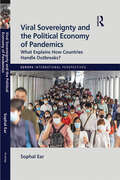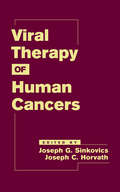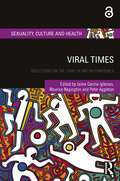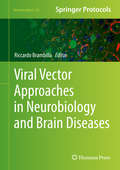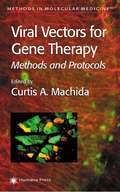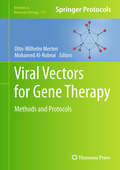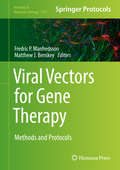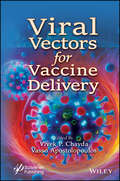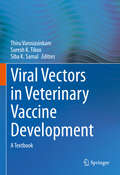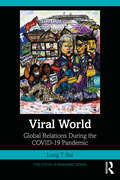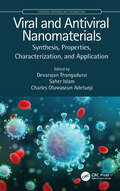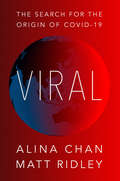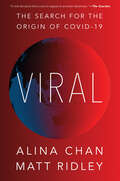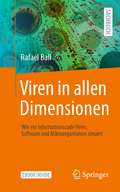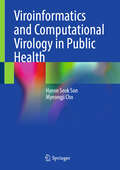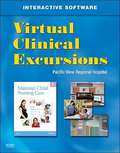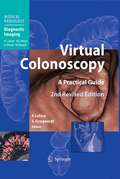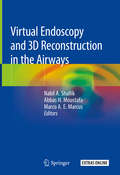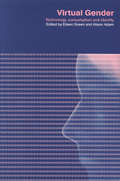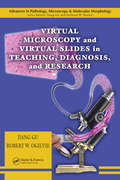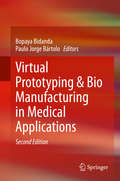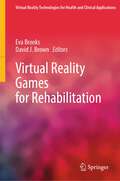- Table View
- List View
Viral Sovereignty and the Political Economy of Pandemics: What Explains How Countries Deal with Outbreaks? (Europa International Perspectives)
by Sophal EarOver the past few decades a number of emerging infectious diseases (EIDs) have disrupted societies throughout the world, including HIV, Ebola, H5N1 (or ‘‘avian flu’’) and SARS, and of course the coronavirus disease (COVID-19) which spread worldwide to become a global pandemic. As well as EIDs, countries and regions also contend with endemic diseases, such as malaria. There are many factors that have contributed to the rise in, and spread of, EIDs and other diseases, including overpopulation, rapid urbanization, environmental degradation, and antibiotic resistance. Political and cultural responses to disease can greatly affect their spread. The global community needs to defend itself against disease threats: one weak link is enough to start a chain reaction that results in a global pandemic such as COVID-19. Some states take a nationalistic approach towards combating disease; however, international cooperation and meaningful ‘‘viral sovereignty’’—empowering countries to create effective health institutions and surveillance systems in order to contain disease—must be considered. This volume, with a focus on Southeast Asia, Africa and North America, considers the intersection between disease, politics, science, and culture in the global battle against pandemics, making use of case studies and interviews to examine the ways in which governments and regions handle outbreaks and pandemics.
Viral Therapy of Human Cancers
by Joseph G. Sinkovics Joseph C. HorvathFeaturing contributions from nearly 30 leading authorities, this pioneering work gauges the potential for viruses to act as oncolytic and anti-tumor agents for the treatment of cancers in humans-detailing the cancer-combative properties exhibited by viruses in nature, genetically engineered viruses, and viral oncolysates as evidenced in basic and e
Viral Times: Reflections on the COVID-19 and HIV Pandemics (Sexuality, Culture and Health)
by Peter Aggleton Jaime García-Iglesias Maurice NagingtonThis book explores the relationship between COVID-19 and AIDS. It considers both how the earlier HIV pandemic informed our engagement with COVID-19, as well as the ways in which COVID-19 has changed how we remember and experience AIDS.Individual sections focus on sexual and intimate relationships, inequalities and injustice, the progressive biomedicalisation of the response (in the absence of a vaccine or effective treatment or cure), and professional, practitioner and community perspectives on the pandemics. The authors come from a wide variety of backgrounds – including public health, nursing, law and legal studies, political studies, and the humanities and social sciences. The book contains contributions by established writers such as Dennis Altman, Shalini Bharat, Tim Dean, Deborah Lupton, Shubhada Maitra, Pauline Oosterhoff and Michael Tan, as well as chapters by Chris Ashford and Gareth Longstaff, Bernard Kelly, Dean Murphy and Kiran Pienaar, and Theodore (ted) Kerr.This thought-provoking and timely volume includes case studies from Australia, Austria, Brazil, Canada, Germany, India, Indonesia, the Philippines, the UK, the USA and Vietnam. It has been written for students and scholars from a wide range of disciplinary backgrounds, including sociology, healthcare, public health, social work, anthropology, and gender and sexuality studies. The book will also be of interest to the general reader who wants a better understanding of the social and cultural dimensions of modern-day pandemics and the personal and community responses to which they give rise.
Viral Vector Approaches in Neurobiology and Brain Diseases
by Riccardo BrambillaAiming toward improvement in the safety, efficiency, and specificity of viral vectors for neurobiological research and clinical applications, Viral Vector Approaches in Neurobiology and Brain Diseases covers key aspects related to the use of viral vectors in neuroscience, with a major emphasis on basic mechanisms of synaptic plasticity, learning, and memory, as well as molecular neuropharmacology and experimental animal models of brain disorders. The volume begins by delving into features of the viral vectors currently available in neuroscience and their production methods, and it then continues onward to examples of successful applications of viral vector technology to psychiatric and memory research, current applications of viral vector technology in the context of neurological disorders, as well as various cutting-edge applications of viral vector technology to neuroscience, including optogenetics. Written for the Neuromethods series, the chapters of this book contain the kind of detailed description and implementation advice that promotes successful, repeatable results. Practical and up to date, Viral Vector Approaches in Neurobiology and Brain Diseases will be useful not only to neurobiologists wishing to routinely use viral vectors in the laboratory but also to experienced scientists needing detailed new protocols for a variety of experimental applications.
Viral Vectors for Gene Therapy
by Curtis A. MachidaResearchers from academia and biotechnology describe proven molecular methods for the construction, development, and use of virus vectors for gene transfer and gene therapy. Offering detailed step-by-step instructions to ensure successful results, these experts detail the use of herpes viruses, adenoviruses, adeno-associated viruses, simple and complex retroviruses, including lentiviruses, and other virus systems for vector development and gene transfer. Additional chapters demonstrate the use of virus vectors in the brain and central nervous system. Comprehensive and highly practical, Viral Vectors for Gene Therapy: Methods and Protocols provides not only researchers with the basic tools needed to design targeted gene delivery vectors, but also clinicians with an understanding of how to apply viral vectors to the treatment of genetic disorders.
Viral Vectors for Gene Therapy
by Otto-Wilhelm Merten Mohamed Al-RubeaiThe huge potential for gene therapy to cure a wide range of diseases has led to high expectations and a great increase in research efforts in this area, particularly in the study of delivery via viral vectors, widely considered to be more efficient than DNA transfection. In Viral Vectors for Gene Therapy: Methods and Protocols, experts in the field present a collection of their knowledge and experience featuring methodologies that involve virus production, transferring protocols, and evaluating the efficacy of gene products. While thoroughly covering the most popular viral vector systems of adenovirus, retrovirus, and adeno-associated virus, this detailed volume also explores less common viral vector systems such as baculovirus, herpes virus, and measles virus, the growing interest in which is creating a considerable demand for large scale manufacturing and purification procedures. Written in the highly successful Methods in Molecular BiologyTM series format, many chapters include introductions to their respective topics, lists of the necessary materials and reagents, step-by-step, readily reproducible laboratory protocols, and vital tips on troubleshooting and avoiding known pitfalls. Comprehensive and practical, Viral Vectors for Gene Therapy: Methods and Protocols provides basic principles accessible to scientists from a wide variety of backgrounds for the development of gene therapy viral products that are safe and effective.
Viral Vectors for Gene Therapy: Methods and Protocols (Methods in Molecular Biology #1937)
by Fredric P. Manfredsson Matthew J. BenskeyThis volume discusses protocols, ranging from vector production to delivery methods, used to execute gene therapy applications. Chapters are divided into four parts, and cover topics such as design, construction, and application of transcription activation-like effectors; multi-modal production of adeno-associated virus; construction of oncolytic herpes simplex virus; AAV-mediated gene delivery to the mouse liver; and intrathecal delivery of gene therapeutics by direct lumbar puncture in mice. Written in the highly successful Methods in Molecular Biology series format, chapters include introductions to their respective topics, lists of the necessary materials and reagents, step-by-step, readily reproducible laboratory protocols, and tips on troubleshooting and avoiding known pitfalls.Comprehensive and authoritative, Viral Vectors for Gene Therapy: Methods and Protocols is a valuable resource for researchers, clinicians, and students looking to utilize viral vectors in gene therapy experiments.
Viral Vectors for Vaccine Delivery
by Vivek Chavda Vasso ApostolopoulosThe book is essential for anyone interested in vaccine development, as it highlights the unique advantages of viral vector vaccines in triggering robust, long-lasting immunity and provides an in-depth exploration of the technology and advancements shaping the future of healthcare. Viral vector vaccines have several unique advantages when compared to other vaccine platforms. These powerful vaccines are capable of triggering long-lasting cellular responses, such as cytotoxic T-lymphocytes, that eradicate virus-infected cells. Viral vector-based vaccines use a harmless virus to smuggle the instructions for making antigens from the disease-causing virus into cells, triggering protective immunity against them. In contrast to conventional antigen-containing vaccines, these vaccines use the body’s natural defense system to produce antigens by using a modified virus to deliver genetic code for an antigen. Viral Vectors for Vaccine Delivery provides a comprehensive overview of viral vectors and their applications in vaccine delivery. Its chapters explore various aspects of viral vector technology, from the basic principles of viral vector construction to the latest advancements in gene editing and manufacturing. Readers will find that the book Offers a deep dive into the world of viral vectors, covering their principles, applications, and potential impact on healthcare; Explores how viral vectors are revolutionizing vaccine development, providing a more effective and targeted approach to disease prevention; Discusses the potential of viral vectors to address emerging health challenges and contribute to a healthier world. Audience Research scholars, pharma-process engineers, research scientists, pharmacy students and professionals from the pharmaceutical and biopharmaceutical industry interested in drug discovery, chemical biology, computational chemistry, medicinal chemistry, and bioinformatics
Viral Vectors in Veterinary Vaccine Development: A Textbook
by Thiru Vanniasinkam Suresh K. Tikoo Siba K. SamalThis highly accessible textbook introduces readers to the development of viral vectors and discusses their application in veterinary vaccinology. It offers comprehensive information on the latest advances in this emerging research field, together with a broad overview of the history of veterinary vaccines and viral vectors. The book also addresses issues concerning funding, translational research and ethics that will impact the future development, manufacture and global use of viral vector-based veterinary vaccines. The book addresses the needs of graduate students and researchers in the fields of Veterinary Medicine, Virology and Immunology.
Viral World: Global Relations During the COVID-19 Pandemic (The COVID-19 Pandemic Series)
by Long T. BuiThis book argues that the catastrophe of COVID-19 provided a momentous time for groups, institutions, and states to reassess their worldviews and relationship to the entire world. Following multiple case studies across dozens of countries throughout the course of the pandemic, this book is a timely contribution to cultural knowledge about the pandemic and the viral politics at the heart of it. Mapping the various forms of global consciousness and connectivity engendered by the crisis, the book offers the framework of "viral worlding," defined as viral forms of relationality, becoming, and communication. It demonstrates how worlding or world-making processes accelerated with the novel coronavirus. New emergent forms of being global "went viral" to address conditions of inequality as well as forge possibilities for societal transformation. Considering the tumult wrought by the pandemic, Bui analyzes progressive movements for democracy, abolition, feminism, environmentalism, and socialism against the world-shattering forces of capitalism, authoritarianism, racism, and militarism. Focusing on ways the pandemic disproportionately impacted marginalized communities, particularly in the Global South, this book juxtaposes the closing of their lifeworlds and social worlds by hegemonic global actors with increased collective demands for freedom, mobility, and justice by vulnerable people. The breadth and depth of the book thus provides students, scholars, and general readers with critical insights to understanding the world(s) of COVID-19 and collective efforts to build better new ones.
Viral and Antiviral Nanomaterials: Synthesis, Properties, Characterization, and Application (Emerging Materials and Technologies)
by Devarajan ThangaduraiThis book summarizes the synthesis, properties, characterization, and application of viral and antiviral nanomaterials by using interdisciplinary subjects ranging from materials science to biomedical science. Viral and Antiviral Nanomaterials: Synthesis, Properties, Characterization, and Application highlights attainments in utilizing nanomaterials as powerful tools for the treatment of viral infections in plants, animals, and humans. It reviews the adopted strategies for designing viral and antiviral nanomaterials for medical applications, including cancer therapy and drug delivery. It also explains the different kinds of antiviral nanosized structures, their chemistries, and the attributes that enable them to be suitable targets for nanotherapeutics. The contributors have prepared the content in a comprehensive manner for readers to use their research findings to improve the healthcare of all living beings. FEATURES Reviews the novel tools for synthesis and characterization of nanomaterials as viral and antiviral agents Explores the different applications of currently available nanomaterials for the treatment of viral infections Investigates the role of antiviral nanodrugs in human and plant systems Addresses the activity of nanostructures in drug-delivery systems for cancer treatment Allows readers from various backgrounds to access the advanced research and practices across traditional frontiers Discusses viral nanomaterials as the viable future of antiviral drugs and nanovaccines in animals and humans This authoritative book is of exceptional relevance to postgraduate scholars, researchers, and scientists interested in nanomedicine, biomedical science, materials science, biopharmaceutical technology, microbiology, and virology to improve virus- and cancer-based therapeutic tools for animal and human welfare.
Viral and Fungal Infections of the Central Nervous System: A Microbiological Perspective
by Hiba Sami Safiya Firoze Parvez A. KhanThis book covers topics related to viral and fungal infections of the central nervous system (CNS), with a multidisciplinary reach, discussing associated immunology, microbiological aspects, pathologies, timely management, and prevention. The book is structured into five broad sections. The first section provides the reader with valuable insights into the aetiologies and underlying pathophysiological mechanisms of neurological diseases, including host responses. It mentions all bacterial, fungal, parasitic, and viral causes of neuro-infections, along with rarer neuropathogenesis such as prions and mycoplasmas. The chapter also presents detailed epidemiology and prevalence of different CNS infections worldwide. It also reviews various infectious diseases that target the nervous system, such as focal lesions, meningitis, and neurological complications of venous sinus thrombosis. The next two sections delve deep into pathogen-specific diseases of the CNS, namely the viruses and fungi associated with neuro-infections. It mentions detailed excerpts on encephalitic viruses, long-term consequences of neurotropic viruses, mycological neuroinfectious, and even the emerging, less talked of viruses and fungi causing neurological disease. Topics such as principles of vigorous antifungal therapy and surgeries are also discussed in the chapter. The fourth section gives an insight on prospects for efficiently diagnosing and managing viral and fungal CNS infections, to tackle associated morbidities. Features that are often less documented, yet of considerable interest in current times, such as the role of immunosuppression in neurological infections and newer microbiological diagnostic strategies are covered. The last section uniquely provides clinicians with relatable case scenarios. Real case descriptions are included, such as cases of fungal meningitis and other difficult-to-diagnose infections produced by viruses. This book serves as a guide for neurologists, medical microbiologists, and clinical practitioners who deal with patients suspected of neurological infection.
Viral: The Search for the Origin of COVID-19
by Matt Ridley Alina ChanA new virus descended on the human species in 2019 wreaking unprecedented havoc. Finding out where it came from and how it first jumped into people is an urgent priority, but early expectations that this would prove an easy question to answer have been dashed. Nearly two years into the pandemic, the crucial mystery of the origin of SARS-CoV-2 is not only unresolved but has deepened. In this uniquely insightful book, a scientist and a writer join forces to try to get to the bottom of how a virus whose closest relations live in bats in subtropical southern China somehow managed to begin spreading among people more than 1,500 kilometres away in the city of Wuhan. They grapple with the baffling fact that the virus left none of the expected traces that such outbreaks usually create: no infected market animals or wildlife, no chains of early cases in travellers to the city, no smouldering epidemic in a rural area, no rapid adaptation of the virus to its new host—human beings. To try to solve this pressing mystery, Viral delves deep into the events of 2019 leading up to 2021, the details of what went on in animal markets and virology laboratories, the records and data hidden from sight within archived Chinese theses and websites, and the clues that can be coaxed from the very text of the virus’s own genetic code. The result is a gripping detective story that takes the reader deeper and deeper into a metaphorical cave of mystery. One by one the authors explore promising tunnels only to show that they are blind alleys, until, miles beneath the surface, they find themselves tantalisingly close to a shaft that leads to the light.
Viral: The Search for the Origin of Covid-19
by Matt Ridley Alina Chan"Chan and Ridley write with an urgency...that inspires gripping depictions of what viruses are, how infectious-disease laboratories work and wonderfully lucid descriptions of bats. . . . They powerfully recount how dangerous pathogens can both leak from a lab and emerge in nature." (New York Times Book Review) Understanding how Covid-19 started is crucial for the future of humankind. Viral is the most incisive and authoritative book about the search for the source of the virus.A new virus descended on the human species in 2019 wreaking unprecedented havoc. Finding out where it came from and how it first jumped into people is an urgent priority, but early expectations that this would prove an easy question to answer have been dashed. Nearly two years into the pandemic, the crucial mystery of the origin of SARS-CoV-2 is not only unresolved but has deepened. In this uniquely insightful book, a scientist and a writer join forces to try to get to the bottom of how a virus whose closest relations live in bats in subtropical southern China somehow managed to begin spreading among people more than 1,500 kilometres away in the city of Wuhan. They grapple with the baffling fact that the virus left none of the expected traces that such outbreaks usually create: no infected market animals or wildlife, no chains of early cases in travellers to the city, no smouldering epidemic in a rural area, no rapid adaptation of the virus to its new host—human beings. To try to solve this pressing mystery, Viral delves deep into the events of 2019 leading up to 2021, the details of what went on in animal markets and virology laboratories, the records and data hidden from sight within archived Chinese theses and websites, and the clues that can be coaxed from the very text of the virus’s own genetic code. The result is a gripping detective story that takes the reader deeper and deeper into a metaphorical cave of mystery. One by one the authors explore promising tunnels only to show that they are blind alleys, until, miles beneath the surface, they find themselves tantalisingly close to a shaft that leads to the light.
Viren in allen Dimensionen: Wie ein Informationscode Viren, Software und Mikroorganismen steuert
by Rafael BallMikroorganismen, Viren und Computerprogramme codieren alle Informationen, die erforderlich sind, sich selbst zu vermehren und verbreiten. Dabei sind sich diese Mechanismen in der belebten Welt, in der Welt der Viren und sogar in der Welt der technischen Systeme verblüffend ähnlich. Das Buch zeigt auf, wie groß die Parallelen dieser verschiedenen belebten und unbelebten replizierenden Systeme sind und worauf sie basieren. Der Ausflug führt ebenso in die faszinierende Welt der Genetik, zur Frage, was Leben definiert und in die Programmierung von Software, die sich selbständig vervielfacht. Schließlich wird daraus die Frage abgeleitet, ob und inwieweit solche sich selbst replizierenden technischen Systeme genauso gefährlich werden können wie infektiöse Viren bei der Auslösung von Pandemien, wie etwa der Corona-Pandemie im Jahr 2020.
Virgin Midwife, Playboy Doctor
by Margaret McdonaghPenhallys most eligible bachelor finds a wife! Oliver Fawkner is new to Penhally Bay. This seriously sexy doctor, with a playboy reputation, has caused quite a stir with the female population! But Oliver is only interested in getting to know beautiful midwife Chloe MacKinnon Chloe loves her job, and dotes on her tiny patients. She has always put work before her social life, hiding from a traumatic past that has left her very inexperienced with men. But this gorgeous new doctor has won her trust and awakened something inside her Chloe knows that Oliver is only passing through Penhally dare she risk her heart with this playboy doctor? BRIDES OF PENHALLY BAY Bachelor doctors become husbands and fathers in a place where hearts are made whole.
Virginia Woolf and Neuropsychiatry
by Maxwell BennettThis book, written by one of the leaders in the field of the neurosciences, will give an explanation of the symptoms and eventual untimely suicide of one of literatures greatest authors; Virginia Woolf. The sources used are letters and statements from Woolf herself, the literature she wrote and comments, letters and any other documentation that referred to her mental state and her medical status. The author will use current insight into depression, the mental consequences of child abuse and drug interactions/effects to illustrate this case study. The book should appeal to researchers in the neurosciences, psychology and psychiatry as well as to a broader audience, mainly individuals who are interested in the (external and internal) forces that drove Woolf to write her material.
Viroinformatics and Computational Virology in Public Health
by Hyeon Seok Son Myeongji ChoThis book is intended as a practical and accessible introduction for those who are new to the field of viral infectious diseases and bioinformatics. It is designed for students, early-career researchers, and anyone looking to explore these topics from the ground up. The book covers basic scientific concepts and provides an overview of the epidemiological aspects of viruses, with a focus on simple analytical methods used to study viruses and viral diseases in the context of public health and computational biology. It introduces fundamental informatics tools for virus research, including software tools and databases, while also covering basic theory, algorithms, and applications in viroinformatics and computational virology. Key topics include the virus life cycle, virus evolution, virus-host interactions, and emerging viral diseases.
Virtual Clinical Excursions: Obstetrics-Pediatrics
by Marilyn J. Hockenberry David Wilson Kelly Ann Crum Patrick BarreraVirtual Clinical Excursions guides you through a virtual hospital setting where the patients are real and their conditions are constantly changing. Each lesson has a textbook reading assignment and activities based on "visiting" the patients in the hospital, which provide a perfect environment in which you may "practice" what you are learning.
Virtual Colonoscopy
by Albert L. Baert Philippe Lefere Stefàan GryspeerdtVirtual colonoscopy is a rapidly evolving technique for the detection of tumoral lesions in the colon. It is now accepted by the American Cancer Society as a valuable screening tool for both colorectal cancer and its adenomatous precursor. With contributions from leaders in the field, this book addresses all the important issues relating to virtual colonoscopy. There is a particular focus on practical aspects, such as how to start virtual colonoscopy in a department, the regular preparation, and the correct scanning parameters. Imaging characteristics and pitfalls are considered in detail, with an extensive pictorial review of difficult lesions; the importance of computer-aided diagnosis is also discussed. In this second edition the text has been updated with the latest study results and developments in technology and new illustrations have been included. This book will be invaluable to every radiologist seeking information on how to perform the exciting technique of virtual colonoscopy.
Virtual Endoscopy and 3D Reconstruction in the Airways
by Nabil A. Shallik Abbas H. Moustafa Marco A. E. MarcusThis book is unique in its approach, covering the impact of virtual endoscopy and 3D reconstruction on surgical modalities and perioperative airway options. Airway management is an essential skill that is practiced daily by almost all anesthetists across the world. Most of the anesthesia-related morbidities and mortalities in the perioperative period are associated with respiratory complications, either of airway or pulmonary problems. Thus, the prediction of airway complications in perioperative period has been an active research field for many decades and is a cornerstone of perioperative anesthesia assessment and management.Virtual endoscopy & 3D reconstruction is a novel, reliable and non-invasive airway assessment tool that is able to reconstruct simple CT images to provide a clear view of the airway down to the bronchial trees, and offers the highest possible sensitivity, comparable with fiberoptic endoscopic pictures. This revolutionary tool avoids the hazards of invasive airway assessment by fiber-optic bronchoscopy, like bleeding from airway masses, sedation induced airway collapse and other complications. This book is a valuable resource for anesthesiologists, intensivists, surgeons, radiologists, otolaryngologists, medical students as well as residents in training.
Virtual Gender: Technology, Consumption and Identity Matters
by Alison Adam Eileen GreenAs yet there has been relatively little published on women's activities in relation to new digital technologies. Virtual Gender brings together theoretical perspectives from feminist theory, the sociology of technology and gender studies with well designed empirical studies to throw new light on the impact of ICTs on contemporary social life.A line-up of authors from around the world looks at the gender and technology issues related to leisure, pleasure and consumption, identity and self. Their research is set against a backcloth of renewed interest in citizenship and ethics and how these concepts are recreated in an on-line situation, particularly in local settings.With chapters on subjects ranging from gender-switching on-line, computer games, and cyberstalking to the use of the domestic telephone, this stimulating collection challenges the stereotype of woman as a passive victim of technology. It offers new ways of looking at the many dimensions in which ICTs can be said to be gendered and will be a rich resource for students and teachers in this expanding field of study.
Virtual Microscopy and Virtual Slides in Teaching, Diagnosis, and Research (Advances in Pathology, Microscopy, & Molecular Morphology)
by Jiang Gu Robert W. OgilvieDespite a brief history, the technologies of virtual microscopy and virtual slides have captured the imagination of many, especially this current crop of students. Having come of age in the computer and Internet age, this emerging group of technicians and researchers tends to display a distinct preference for virtual slides and virtual microscopes.
Virtual Prototyping & Bio Manufacturing in Medical Applications
by Paulo Jorge Bártolo Bopaya BidandaThe original role of RP was to confirm the shape and feel of concept design, but innovations in RP now allow for the development of sophisticated medical devices such as catheters, stents, drug delivery systems, syringes and cardio-vascular devices, and more. RP has moved beyond medical devices, as surgeons now regularly use RP models to brainstorm strategies for surgeries. This book presents new uses for rapid prototyping in state-of-the-art medical applications.
Virtual Reality Games for Rehabilitation (Virtual Reality Technologies for Health and Clinical Applications)
by Eva Brooks David J. BrownThis volume focuses on games to manage and facilitate rehabilitation. It emphasizes user practice, attitudes, and experience, and their changing place within developing rehabilitation frameworks. It looks at how users have adopted, integrated, and innovated with games to facilitate rehabilitation. Topics include game technology, game design and accessibility, web-based technologies vs pervasive and mobile technologies, social and collaborative aspects, and rehabilitative outcome. Games for rehabilitation are gaining interest from different communities such as medicine, psychology, and rehabilitation. A distinction can be made between games specifically made for rehabilitative purposes and games made for the general public but that are used in rehabilitation as well. Games have allowed the building of new/complementary forms for rehabilitation and offered new options to produce rehabilitative activities and experiences.
